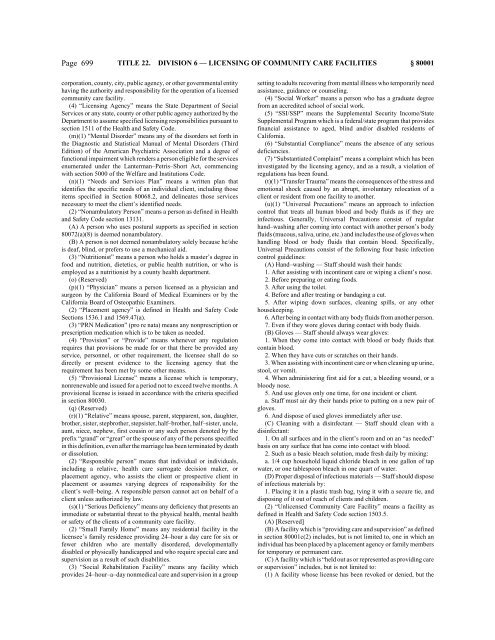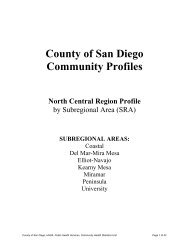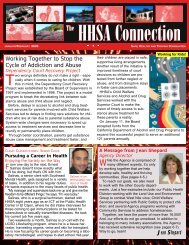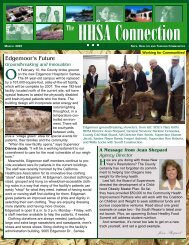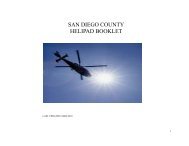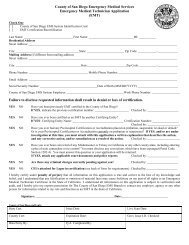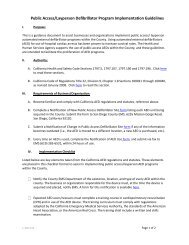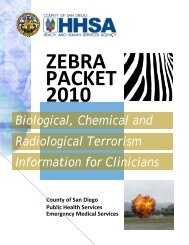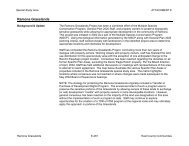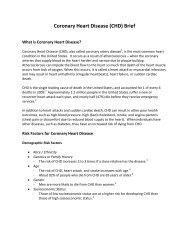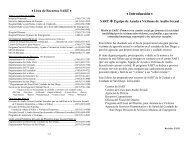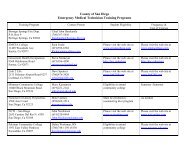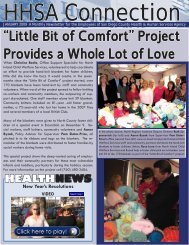CALIFORNIA CODE OF REGULATIONS - State of California
CALIFORNIA CODE OF REGULATIONS - State of California
CALIFORNIA CODE OF REGULATIONS - State of California
You also want an ePaper? Increase the reach of your titles
YUMPU automatically turns print PDFs into web optimized ePapers that Google loves.
Page 699<br />
TITLE 22. DIVISION 6 — LICENSING <strong>OF</strong> COMMUNITY CARE FACILITIES § 80001<br />
corporation, county, city, public agency, or other governmental entity<br />
having the authority and responsibility for the operation <strong>of</strong> a licensed<br />
community care facility.<br />
(4) “Licensing Agency” means the <strong>State</strong> Department <strong>of</strong> Social<br />
Services or any state, county or other public agency authorized by the<br />
Department to assume specified licensing responsibilities pursuant to<br />
section 1511 <strong>of</strong> the Health and Safety Code.<br />
(m)(1) “Mental Disorder” means any <strong>of</strong> the disorders set forth in<br />
the Diagnostic and Statistical Manual <strong>of</strong> Mental Disorders (Third<br />
Edition) <strong>of</strong> the American Psychiatric Association and a degree <strong>of</strong><br />
functional impairment which renders a person eligible for the services<br />
enumerated under the Lanterman–Petris–Short Act, commencing<br />
with section 5000 <strong>of</strong> the Welfare and Institutions Code.<br />
(n)(1) “Needs and Services Plan” means a written plan that<br />
identifies the specific needs <strong>of</strong> an individual client, including those<br />
items specified in Section 80068.2, and delineates those services<br />
necessary to meet the client’s identified needs.<br />
(2) “Nonambulatory Person” means a person as defined in Health<br />
and Safety Code section 13131.<br />
(A) A person who uses postural supports as specified in section<br />
80072(a)(8) is deemed nonambulatory.<br />
(B) A person is not deemed nonambulatory solely because he/she<br />
is deaf, blind, or prefers to use a mechanical aid.<br />
(3) “Nutritionist” means a person who holds a master’s degree in<br />
food and nutrition, dietetics, or public health nutrition, or who is<br />
employed as a nutritionist by a county health department.<br />
(o) (Reserved)<br />
(p)(1) “Physician” means a person licensed as a physician and<br />
surgeon by the <strong>California</strong> Board <strong>of</strong> Medical Examiners or by the<br />
<strong>California</strong> Board <strong>of</strong> Osteopathic Examiners.<br />
(2) “Placement agency” is defined in Health and Safety Code<br />
Sections 1536.1 and 1569.47(a).<br />
(3) “PRN Medication” (pro re nata) means any nonprescription or<br />
prescription medication which is to be taken as needed.<br />
(4) “Provision” or “Provide” means whenever any regulation<br />
requires that provisions be made for or that there be provided any<br />
service, personnel, or other requirement, the licensee shall do so<br />
directly or present evidence to the licensing agency that the<br />
requirement has been met by some other means.<br />
(5) “Provisional License” means a license which is temporary,<br />
nonrenewable and issued for a period not to exceed twelve months. A<br />
provisional license is issued in accordance with the criteria specified<br />
in section 80030.<br />
(q) (Reserved)<br />
(r)(1) “Relative” means spouse, parent, stepparent, son, daughter,<br />
brother, sister, stepbrother, stepsister, half–brother, half–sister, uncle,<br />
aunt, niece, nephew, first cousin or any such person denoted by the<br />
prefix “grand” or “great” or the spouse <strong>of</strong> any <strong>of</strong> the persons specified<br />
in this definition, even after the marriage has been terminated by death<br />
or dissolution.<br />
(2) “Responsible person” means that individual or individuals,<br />
including a relative, health care surrogate decision maker, or<br />
placement agency, who assists the client or prospective client in<br />
placement or assumes varying degrees <strong>of</strong> responsibility for the<br />
client’s well–being. A responsible person cannot act on behalf <strong>of</strong> a<br />
client unless authorized by law.<br />
(s)(1) “Serious Deficiency” means any deficiency that presents an<br />
immediate or substantial threat to the physical health, mental health<br />
or safety <strong>of</strong> the clients <strong>of</strong> a community care facility.<br />
(2) “Small Family Home” means any residential facility in the<br />
licensee’s family residence providing 24–hour a day care for six or<br />
fewer children who are mentally disordered, developmentally<br />
disabled or physically handicapped and who require special care and<br />
supervision as a result <strong>of</strong> such disabilities.<br />
(3) “Social Rehabilitation Facility” means any facility which<br />
provides 24–hour–a–day nonmedical care and supervision in a group<br />
setting to adults recovering from mental illness who temporarily need<br />
assistance, guidance or counseling.<br />
(4) “Social Worker” means a person who has a graduate degree<br />
from an accredited school <strong>of</strong> social work.<br />
(5) “SSI/SSP” means the Supplemental Security Income/<strong>State</strong><br />
Supplemental Program which is a federal/state program that provides<br />
financial assistance to aged, blind and/or disabled residents <strong>of</strong><br />
<strong>California</strong>.<br />
(6) “Substantial Compliance” means the absence <strong>of</strong> any serious<br />
deficiencies.<br />
(7) “Substantiated Complaint” means a complaint which has been<br />
investigated by the licensing agency, and as a result, a violation <strong>of</strong><br />
regulations has been found.<br />
(t)(1) “Transfer Trauma” means the consequences <strong>of</strong> the stress and<br />
emotional shock caused by an abrupt, involuntary relocation <strong>of</strong> a<br />
client or resident from one facility to another.<br />
(u)(1) “Universal Precautions” means an approach to infection<br />
control that treats all human blood and body fluids as if they are<br />
infectious. Generally, Universal Precautions consist <strong>of</strong> regular<br />
hand–washing after coming into contact with another person’s body<br />
fluids (mucous, saliva, urine, etc.) and includes the use <strong>of</strong> gloves when<br />
handling blood or body fluids that contain blood. Specifically,<br />
Universal Precautions consist <strong>of</strong> the following four basic infection<br />
control guidelines:<br />
(A) Hand–washing — Staff should wash their hands:<br />
1. After assisting with incontinent care or wiping a client’s nose.<br />
2. Before preparing or eating foods.<br />
3. After using the toilet.<br />
4. Before and after treating or bandaging a cut.<br />
5. After wiping down surfaces, cleaning spills, or any other<br />
housekeeping.<br />
6. After being in contact with any body fluids from another person.<br />
7. Even if they wore gloves during contact with body fluids.<br />
(B) Gloves — Staff should always wear gloves:<br />
1. When they come into contact with blood or body fluids that<br />
contain blood.<br />
2. When they have cuts or scratches on their hands.<br />
3. When assisting with incontinent care or when cleaning up urine,<br />
stool, or vomit.<br />
4. When administering first aid for a cut, a bleeding wound, or a<br />
bloody nose.<br />
5. And use gloves only one time, for one incident or client.<br />
a. Staff must air dry their hands prior to putting on a new pair <strong>of</strong><br />
gloves.<br />
6. And dispose <strong>of</strong> used gloves immediately after use.<br />
(C) Cleaning with a disinfectant — Staff should clean with a<br />
disinfectant:<br />
1. On all surfaces and in the client’s room and on an “as needed”<br />
basis on any surface that has come into contact with blood.<br />
2. Such as a basic bleach solution, made fresh daily by mixing:<br />
a. 1/4 cup household liquid chloride bleach in one gallon <strong>of</strong> tap<br />
water, or one tablespoon bleach in one quart <strong>of</strong> water.<br />
(D) Proper disposal <strong>of</strong> infectious materials — Staff should dispose<br />
<strong>of</strong> infectious materials by:<br />
1. Placing it in a plastic trash bag, tying it with a secure tie, and<br />
disposing <strong>of</strong> it out <strong>of</strong> reach <strong>of</strong> clients and children.<br />
(2) “Unlicensed Community Care Facility” means a facility as<br />
defined in Health and Safety Code section 1503.5.<br />
(A) [Reserved]<br />
(B) A facility which is “providing care and supervision” as defined<br />
in section 80001c(2) includes, but is not limited to, one in which an<br />
individual has been placed by a placement agency or family members<br />
for temporary or permanent care.<br />
(C) A facility which is “held out as or represented as providing care<br />
or supervision” includes, but is not limited to:<br />
(1) A facility whose license has been revoked or denied, but the


